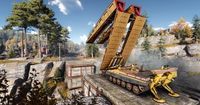For fans eagerly diving into Hollow Knight: Silksong, one of the first and most pressing challenges isn’t a boss battle or a tricky platforming section—it’s simply finding your way around. The sprawling, labyrinthine world of Pharloom is packed with secrets, hazards, and winding paths, making a reliable map an absolute necessity. But, as many players have quickly discovered, getting your hands on a map in Silksong isn’t as straightforward as you might hope. In fact, it’s a quest in itself, requiring keen ears, a bit of platforming prowess, and a stash of the in-game currency, Rosary Beads.
According to both Eurogamer.net and Polygon, published on September 5, 2025, unlocking the map is one of the first major hurdles for new players. Unlike many games that hand over a map at the outset, Silksong makes you work for it—and then pay for the privilege. The process begins with tracking down Shakra, a traveling warrior who moonlights as Pharloom’s resident cartographer and map merchant. Shakra isn’t just any shopkeeper; she’s a character you’ll locate by following the sound of her singing, which grows louder as you draw near. As Eurogamer.net puts it, “You’ll know when Shakra is nearby as you’ll be able to hear her singing. Follow her voice as it gradually gets louder until you find her!”
But Shakra doesn’t have a single storefront. She appears in various locations across Pharloom, and you’ll need to seek her out in each new area you wish to map. The first encounter typically happens in The Marrow, a region accessible after some early-game exploration. Polygon offers a step-by-step guide to reaching her from the village of Bone Bottom, providing platforming tips and enemy warnings along the way. Once you reach the right spot—signaled by gold rings on the ground and Shakra’s unmistakable song—you’re ready to begin your cartographic journey.
Here’s where the real business begins. Shakra’s maps don’t come cheap, and you’ll need Rosary Beads to make a purchase. The Mosslands Map costs 40 Rosary Beads, while The Marrow Map is priced at 50. Each map unlocks a rough outline of its respective area, but don’t expect a fully detailed chart right out of the gate. As Polygon notes, “Both map fragments only offer a rough outline of each respective area.” And there’s a catch: you’ll need to buy a separate map for every new region you enter, with prices climbing as you progress deeper into Pharloom. Eurogamer.net warns, “The price of maps will increase the further you explore. Due to this, it’s a good idea to do some Rosary Bead farming before venturing into a new location.”
Even after shelling out for a map, players quickly realize it’s not as useful as they might hope. The basic map is sparse, missing crucial details like explored paths, benches, and your current location. To remedy this, Shakra sells a variety of upgrades and pins—each for an additional fee. The Quill, priced at 50 Rosary Beads, is a permanent upgrade that fills in the areas you’ve traversed after you rest on a bench. This feature is essential, as it helps you keep track of where you’ve been and highlights unexplored routes. Polygon emphasizes, “This upgrade is critical. It doesn’t just give you a sense of where you’ve already gone—but where you need to go, as well.”
Next on the shopping list is the Compass, which costs 70 Rosary Beads. This item displays your current location on the map, a lifesaver for those prone to getting turned around in the game’s twisting corridors. There’s a trade-off, though: the Compass takes up a valuable slot on your crest, so players need to weigh its benefits against other possible upgrades. To further ease navigation, Bench Pins (60 Rosary Beads) mark the locations of benches—handy for planning rest stops and saving progress. Additional pins, like Vendor Pins (80 Rosary Beads) and Bellway Pins (60 Rosary Beads), can be purchased to mark merchants and fast travel stations, making the map even more informative.
The full suite of early-game mapping tools—two maps, the Quill, Compass, and Bench Pins—will set you back a total of 280 Rosary Beads. For new players, this is a significant investment, and both Eurogamer.net and Polygon recommend prioritizing Rosary Bead farming to afford these essential items. Polygon even references a dedicated guide for the best early-game farming spots, underscoring just how central this currency is to the mapping experience.
Players are encouraged to convert loose Rosary Beads into Rosary Strings to avoid losing them—another layer of resource management in a game already known for its challenging gameplay. As Eurogamer.net points out, “You may also want to consider turning your loose beads into Rosary Strings to ensure you don’t lose them!”
Once you’ve made your purchases, accessing the map is straightforward. Hold the left bumper on your controller or press the “M” key on your keyboard to pull up the map, which now includes a dedicated tab in your journal. With the Quill, explored areas are filled in after each rest, and with the Compass, you’ll always know your precise location. The additional pins make it easy to spot benches, merchants, and other points of interest, transforming the once-barebones map into a vital tool for exploration.
For those still struggling to piece together Pharloom’s intricate layout, there’s further help available. Eurogamer.net highlights an interactive map created by Map Genie, embedded directly in their guide, allowing players to plan routes and mark secrets outside the game itself. This resource has quickly become a favorite among the community, especially for those aiming to uncover every hidden nook and cranny.
It’s worth noting that the process of unlocking and upgrading the map is more than just a gameplay mechanic—it’s a design choice that shapes the entire Silksong experience. By making players work for their map, the developers at Team Cherry encourage careful exploration, resource management, and a sense of discovery that’s all too rare in modern games. The incremental upgrades and the need to track down Shakra in each area add layers of challenge and reward, making every new map fragment feel earned.
In the end, while the path to a fully functional map in Hollow Knight: Silksong is winding and sometimes costly, it’s also deeply satisfying. With a little perseverance—and a lot of Rosary Beads—players can transform their journey from disoriented wanderer to master cartographer, ready to uncover every secret Pharloom has to offer.





